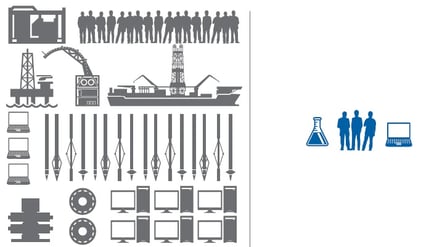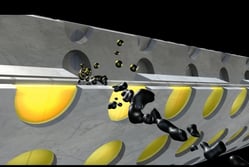The oil and gas industry is faced with difficult trading times and low oil prices are predicted to continue. Operators and service companies are faced with lower margins and less capital available when making decisions on reservoir production strategies. Working with reduced resource is difficult enough, but production targets still must be met.
In order to meet these challenges a number of different innovative technologies have been developed and tested in the field that assist with reservoir production optimisation at reduced costs when compared to conventional methods. As an example, the use of speciality chemical technologies can eliminate the need to carry out costly production logging and gain critical data on fluid flow which in turn can be used to optimise development plans.
The technologies can measure clean out efficiency, pinpoint areas of fluid flow, and ultimately log production rates from various zones. All of this data can be obtained throuhg reservoir tracers without the need for intervention the cost of which can run into the hundreds of thousands or even millions of dollars when looking at a sub-sea development. What’s more, this data can be taken on-stream and over several years, saving on rig time as the technology is integrated down hole when running the lower completion into the well.
Below we will examine the steps you can take applying this alternative technology to make significant savings on rig time.
Six steps to making significant saving in reservoir inflow monitoring
STEP 1: Identify what you would like to measure
You primary goal in the current climate is likely to be to get more for less. What measurements will allow you to optimise production? How much will they cost? You should consider the future life of the well. In years to come what will be important data to capture?
If you are looking at reducing PLT activity in favour of data gained from tracer application known as a Tracer Production Log™ (TPL) you need to consider what data you would have collected from the missing PLTs and base the tracer strategy around that.
Tracerco has many tracers to characterise oil and water inflow in complex reservoirs and in multiple zones so the project can be designed to meet specific measurement requirements.
STEP 2: Consider your options
Applying a TPL to your completion is an upfront investment and will require justification. You need to clearly identify what benefits it will bring and monetise them so you are clear on the purpose of the project.
Ask yourself what can you get from the data? Will it enable maximised reservoir production? Where will the savings come from?
With regard to making savings on PLTs, if you have followed step one and identified what you want to measure, a sensitivity analysis on payback from PLT savings versus TPL application can help with decision making.
STEP 3: Apply the TPL
Once the project design has been agreed, the appropriate reservoir tracers can be selected for the project. Tracerco has an extensive library of unique species. They are non-toxic, non-radioactive, and have excellent longevity.
Tracerco tracers can be applied to any normal completion design at manufacturing sites, customer sites or at a Tracerco facility. They are flexible, heat-resistant, and highly adaptable.
STEP 4: Take the sample
Samples are taken at regular intervals as determined by the measurement requirements. As the tracer is released extremely slowly, and only activated through contact with the targeted fluid it is designed to measure, the sampling strategy could last several years.
Samples can be taken by Tracerco or the client and only a very small amount is required in order to detect tracer presence; as low as parts per trillion.
STEP 5: Interpret the data and take appropriate action
Samples are analysed for the presence of tracer. The presence of a specific tracer and its concentration in production fluids allows a fluid in-flow profile to be generated at a given point in time.
If using Tracerco technology, samples can be analysed on site in one of our unique state of the art mobile labs, thus giving data in hours rather than the weeks it can take to send samples away for analysis. This also avoids the complexity of transporting samples particularly in countries with onerous export regulations. The advantage here is clear; critical inflow data is readily available allowing operators to ensure adequate clean out has occurred and if not, re-enter the well to resolve any issues improving recovery rates and production targets.
Alternatively samples can be sent to one of our eight fixed labs located globally.
A fluid inflow profile can determine the most prolific production zones and identify the source of oil and water production from individual wellbore positions. This data allows optimisation of development plans to maximise oil recovery and minimize water production.
STEP 6: Keep a record of the savings
Keep a record of the savings you have made. The original sensitivity analysis conducted in step two can be useful here. You will also have evidence of the production optimisation achieved through using the TPL, which will allow you to improve on your next project and make savings in future wells. It can make future well strategy decisions much easier once a track record has been established.
For more information please request a lunch and learn.
More from our technology enabling cost savings series includes how you could save up to 66%of your drilling costs in unconventional fields.

